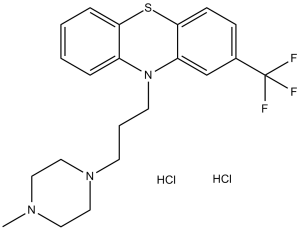TRIFLUOPERAZINE 2HCL (TFP; SKF5019)
This product is for research use only, not for human use. We do not sell to patients.

For small sizes, please check our retail website as below: www.invivochem.com
| Size | Price | Stock |
|---|---|---|
| 2g | $150 | Check With Us |
| 5g | $250 | Check With Us |
| 10g | $375 | Check With Us |
Cat #: V2537 CAS #: 440-17-5 Purity ≥ 98%
Description: Trifluoperazine dihydrochloride (TFP; SKF5019), a typical phenothiazine class of antipsychotic mainly used to treat schizophrenia, is a dopamine D2 receptor inhibitor with IC50 of 1.1 NM.
Top Publications Citing Invivochem Products
Publications Citing InvivoChem Products
Product Promise

- Physicochemical and Storage Information
- Protocol
- Related Biological Data
- Stock Solution Preparation
- Quality Control Documentation
| Molecular Weight (MW) | 480.42 |
|---|---|
| Molecular Formula | C21H24F3N3S.2HCl |
| CAS No. | 440-17-5 |
| Storage | -20℃ for 3 years in powder formr |
| -80℃ for 2 years in solvent | |
| Solubility In Vitro | DMSO: 88 mg/mL (183.2 mM)r |
| Water: 96 mg/mL (199.8 mM)r | |
| Ethanol: 96 mg/mL (199.8 mM) | |
| SMILES Code | FC(C(C=C1N2CCCN3CCN(C)CC3)=CC=C1SC4=C2C=CC=C4)(F)F.[H]Cl.[H]Cl |
| Synonyms | SKF5019; SKF 5019; SKF-5019; Trifluoperazine hydrochloride; NSC 17474; NSC-17474; NSC17474; Trifluoperazine HCl; Tryptazine dihydrochloride; Trazine; |
| Protocol | In Vitro | Trifluoperazine dihydrochloride is a long-established, widely used 'conventional' antipsychotic agent. Trifluoperazine dihydrochloride has been an extensively studied drug molecule that has been used as a calmodulin inhibitor. |
|---|
These protocols are for reference only. InvivoChem does not
independently validate these methods.
| Solvent volume to be added | Mass (the weight of a compound) | |||
|---|---|---|---|---|
| Mother liquor concentration | 1mg | 5mg | 10mg | 20mg |
| 1mM | 2.0815 mL | 10.4076 mL | 20.8151 mL | 41.6302 mL |
| 5mM | 0.4163 mL | 2.0815 mL | 4.1630 mL | 8.3260 mL |
| 10mM | 0.2082 mL | 1.0408 mL | 2.0815 mL | 4.1630 mL |
| 20mM | 0.1041 mL | 0.5204 mL | 1.0408 mL | 2.0815 mL |
The molarity calculator equation
Mass(g) = Concentration(mol/L) × Volume(L) × Molecular Weight(g/mol)
Mass
=
Concentration
×
Volume
×
Molecular Weight*
The dilution calculator equation
Concentration(start)
×
Volume(start)
=
Concentration(final)
×
Volume(final)
This equation is commonly abbreviated as: C1 V1 = C2 V2
Concentration(start)
C1
×
Volume(start)
V1
=
Concentration(final)
C2
×
Volume(final)
V2
Step One: Enter information below
Dosage mg/kg
Average weight of animals g
Dosing volume per animal µL
Number of animals
Step Two: Enter the in vivo formulation
%DMSO
+
%
+
%Tween 80
+
%ddH2O
Calculation Results:
Working concentration:
mg/ml;
Method for preparing DMSO master liquid:
mg
drug pre-dissolved in
µL
DMSO(Master liquid concentration
mg/mL)
,Please contact us first if the concentration exceeds the DMSO solubility of the batch of drug.
Method for preparing in vivo formulation:
Take
µL
DMSO master liquid, next add
µL
PEG300, mix and clarify, next add
µL
Tween 80,mix and clarify, next add
µL
ddH2O,mix and clarify.
Note:
- (1) Please be sure that the solution is clear before the addition of next solvent. Dissolution methods like vortex, ultrasound or warming and heat may be used to aid dissolving.
- (2) Be sure to add the solvent(s) in order.




































